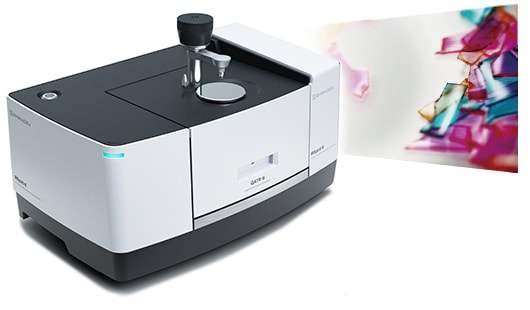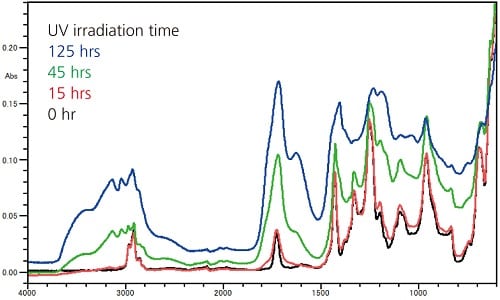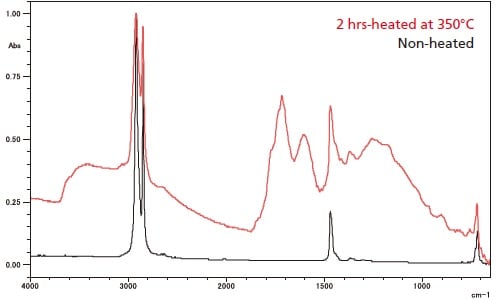
2021-02-19
Approaches to Contaminant and Degradation Analysis with FTIR
In this presentation, we introduce the analysis of contaminants in plastics as well as degradation analysis, both using the technique of FTIR.
Fourier Transform Infrared Spectrophotometer Plastic Analysis System

The Plastic Analyzer method package includes an FTIR spectral library for plastics degraded by UV rays and heat. Utilizing searches of this library demonstrates its effectiveness in the analysis of unknown samples that are difficult to identify with standard libraries. Examples include plastics degraded by exposure to UV rays as well as contaminants and defective items altered by heating.

When analyzing plastics, libraries are used to qualify their material properties. However, infrared spectra of plastics that have been denatured (have deteriorated) due to heat or UV rays differ in shape from standard spectra, and qualifying them can sometimes be difficult.
To address this, the Plastic Analyzer includes a deterioration library, so highly accurate qualification can be performed reflecting the state of deterioration.

This library includes more than 300 spectra from the UV degradation of 14 types of plastic. This proprietary Shimadzu library includes the IR spectra for plastics degraded by UV rays for the equivalent of approximately 10 years using a super accelerated weathering chamber from Iwasaki Electric Co., Ltd.

This library includes more than 100 spectra from the degradation of 13 types of plastic heated to between 200 and 400 °C. This proprietary Shimadzu library contains IR spectra for plastics degraded by heating, acquired through measurements at the Hamamatsu Technical Support Center at the Industrial Research Institute of Shizuoka Prefecture.

The system includes plastic measurement parameters and IR Pilot, a special program for IRSpirit-X Series that simplifies spectral measurements and the creation of reports, enabling analysts to perform everything from the measurement of target samples to data analysis easily. Even users unfamiliar with FTIR analysis can start work immediately.
Never misidentify plastic contaminants! - Plastic Analyzer -
Identification of Weathered Microplastics
Measurement of Microplastics and Use of Thermal-Damaged Plastics Library
For analysis of Microplastics, Fourier Transform Infrared Spectrophotometer (FTIR), which excels at qualitative analysis of organic compounds, is suitable. In this section, we introduce an example of measuring microplastics of several millimeters using compact FTIR.
Download the latest brochure.
| Documents | Date Creation Date |
|---|---|
2021-01-26 |
FTIR TALK LETTER Vol. 43 has been published
The article about the Introduction to the Spectrum Advisor can be used on all Shimadzu FTIR systems controlled by LabSolutions IR. Learn the key points of infrared spectral analysis for aliphatic unsaturated hydrocarbons and aromatics.
Analytical Solutions for Microplastics
Shimadzu provides analytical and measuring instruments for the study of a variety of plastic materials: for R&D, characteristic evaluation of raw materials, quality control for plastic products, and deterioration analysis. With these diverse techniques, Shimadzu provides optimal solutions for microplastics research.
Shimadzu has released the IRSpirit-X Series
IRSpirit FTIR spectrophotometers are extremely compact, but can still be used with standard accessories from Shimadzu and other manufacturers. IRSpirit instruments come with IR Pilot software, which offers 23 application programs without the need for parameter setup. Measure multiple samples with just a few clicks.
Shimadzu has released the MAP-100
The MAP-100 automates the typical steps needed to isolate microplastics. This improves the reproducibility of the analytical workflow, enables lab technicians to focus on other tasks, and makes handling of reagents safer.
Latest issue of Shimadzu Journal, featuring Forensics / Toxicology, has come out.
This issue focuses on "Forensics / Toxicology", an area where science and technology are particularly important and needed. It starts with two customer interviews.
Cellulose nanofibers
Given that cellulose nanofibers(CNFs)offer attractive physical characteristics, such as light weight, strength, and hardness, they not only enable materials with advanced functionality, but are expected to be used as a reinforcing material that can reduce the weight of composite materials.
